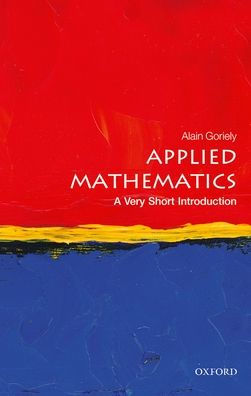Applied Mathematics: A Very Short Introduction
Mathematics is playing an increasingly important role in society and the sciences, enhancing our ability to use models and handle data. While pure mathematics is mostly interested in abstract structures, applied mathematics sits at the interface between this abstract world and the world in which we live. This area of mathematics takes its nourishment from society and science and, in turn, provides a unified way to understand problems arising in diverse fields.
This Very Short Introduction presents a compact yet comprehensive view of the field of applied mathematics, and explores its relationships with (pure) mathematics, science, and engineering. Explaining the nature of applied mathematics, Alain Goriely discusses its early achievements in physics and engineering, and its development as a separate field after World War II. Using historical examples, current applications, and challenges, Goriely illustrates the particular role that mathematics plays in the modern sciences today and its far-reaching potential.
ABOUT THE SERIES: The Very Short Introductions series from Oxford University Press contains hundreds of titles in almost every subject area. These pocket-sized books are the perfect way to get ahead in a new subject quickly. Our expert authors combine facts, analysis, perspective, new ideas, and enthusiasm to make interesting and challenging topics highly readable.
"1127152068"
This Very Short Introduction presents a compact yet comprehensive view of the field of applied mathematics, and explores its relationships with (pure) mathematics, science, and engineering. Explaining the nature of applied mathematics, Alain Goriely discusses its early achievements in physics and engineering, and its development as a separate field after World War II. Using historical examples, current applications, and challenges, Goriely illustrates the particular role that mathematics plays in the modern sciences today and its far-reaching potential.
ABOUT THE SERIES: The Very Short Introductions series from Oxford University Press contains hundreds of titles in almost every subject area. These pocket-sized books are the perfect way to get ahead in a new subject quickly. Our expert authors combine facts, analysis, perspective, new ideas, and enthusiasm to make interesting and challenging topics highly readable.
Applied Mathematics: A Very Short Introduction
Mathematics is playing an increasingly important role in society and the sciences, enhancing our ability to use models and handle data. While pure mathematics is mostly interested in abstract structures, applied mathematics sits at the interface between this abstract world and the world in which we live. This area of mathematics takes its nourishment from society and science and, in turn, provides a unified way to understand problems arising in diverse fields.
This Very Short Introduction presents a compact yet comprehensive view of the field of applied mathematics, and explores its relationships with (pure) mathematics, science, and engineering. Explaining the nature of applied mathematics, Alain Goriely discusses its early achievements in physics and engineering, and its development as a separate field after World War II. Using historical examples, current applications, and challenges, Goriely illustrates the particular role that mathematics plays in the modern sciences today and its far-reaching potential.
ABOUT THE SERIES: The Very Short Introductions series from Oxford University Press contains hundreds of titles in almost every subject area. These pocket-sized books are the perfect way to get ahead in a new subject quickly. Our expert authors combine facts, analysis, perspective, new ideas, and enthusiasm to make interesting and challenging topics highly readable.
This Very Short Introduction presents a compact yet comprehensive view of the field of applied mathematics, and explores its relationships with (pure) mathematics, science, and engineering. Explaining the nature of applied mathematics, Alain Goriely discusses its early achievements in physics and engineering, and its development as a separate field after World War II. Using historical examples, current applications, and challenges, Goriely illustrates the particular role that mathematics plays in the modern sciences today and its far-reaching potential.
ABOUT THE SERIES: The Very Short Introductions series from Oxford University Press contains hundreds of titles in almost every subject area. These pocket-sized books are the perfect way to get ahead in a new subject quickly. Our expert authors combine facts, analysis, perspective, new ideas, and enthusiasm to make interesting and challenging topics highly readable.
12.99
In Stock
5
1

Applied Mathematics: A Very Short Introduction
176
Applied Mathematics: A Very Short Introduction
176
12.99
In Stock

Product Details
| ISBN-13: | 9780198754046 |
|---|---|
| Publisher: | Oxford University Press |
| Publication date: | 04/22/2018 |
| Series: | Very Short Introductions |
| Pages: | 176 |
| Sales rank: | 503,112 |
| Product dimensions: | 4.30(w) x 6.80(h) x 0.50(d) |
About the Author
From the B&N Reads Blog
